Dear Tom,
I work for a library system in Missouri and am in need of advice/recommendations. The Library owns a unique piece of property which includes a historic home built in 1855-56 (Greek Revival style) which served as a farm in its early years. We have raised private funds for the adaptive reuse of the home as a center for storytelling. We’ve worked with an architect and construction company that specialize in historic preservation and have tried to retain as much of the historic nature as possible.
There are two areas of the home (the entry and parlor) for which we’d like to find appropriate historic fixtures (which is not my area of expertise). I have looked at several of the fixtures on your site and wonder if you might have recommendations for the two spaces I mentioned. I am including pictures of both spaces if you are willing to make suggestions. You’ll notice in the parlor that we’ve purchased and installed a 1915 inverted dome but the scale and style don’t look quite right in the space. Any advice you can give would be greatly appreciated!
Thank you,
D – MO
——————–
Hi D,
Thank you for your email.
Thank you for your photos.
I will try to do the best I can without room size and ceiling heights.
Here is what the period looks like:
https://www.genuineantiquelighting.net/pc/CHA1/2337g/Gothic_Revival_4-light_Gas_Chandelier.html
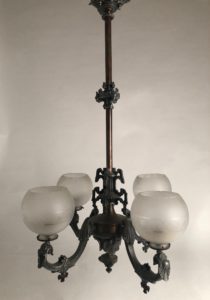
Antique Gothic Revival Chandelier Light, 2337g
I see that you have chosen an Inverted Dome for the room with the piano.
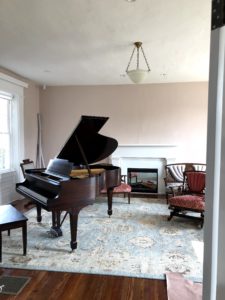
Inverted Domes are fixtures that were from the period after the turn of the 20th century. But there are three reasons why I like them for your application.
In a room with already existing details something like 2337G may be hard to integrate with all its ornateness. It might fight with the detail that is already there.
Second this is a Farm House which tends to have a more minimal use of the ornateness of the period.
Third your intended use is more on non residential form. An Inverted Dome can be close to the period but be more Architectural in design and therefor easier to integrate into a room with detail that already exists. They also supply plenty of illumination for use with groups.
Here are some White and Amber Slag Glass inverted Domes:
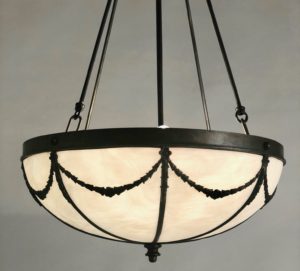
Antique Slag Glass Inverted Dome Ceiling Light, Circa 1915
https://www.genuineantiquelighting.net/pc/ID1/3340d/Cameo_Inverted_Dome_Ceiling_Light.html
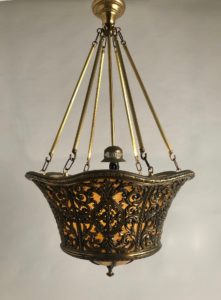
Cameo Inverted Dome Ceiling Light, Circa 1920
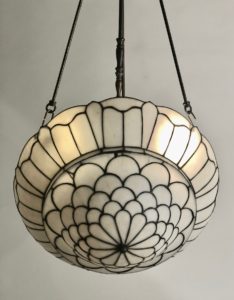
White Leaded Glass Inverted Dome Ceiling Light, Circa 1905
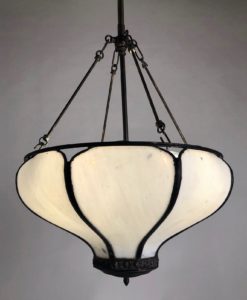
White Slag Glass Inverted Dome Ceiling Light, Circa 1920
https://www.genuineantiquelighting.net/pc/ID1/3309d/Unusual_Inverted_Slag_Dome_Light.html
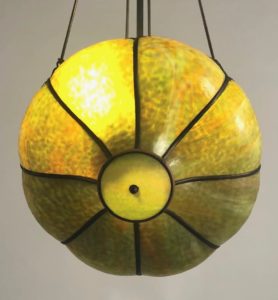
Unusual Inverted Slag Dome Light,Circa 1915
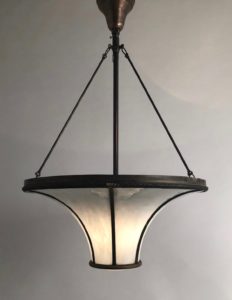
Opalescent Tapered Slag Glass Inverted Dome Ceiling Lights, Circa 1915
https://www.genuineantiquelighting.net/pc/ID1/3283d/Amber_Slag_Glass_Inverted_Dome.html
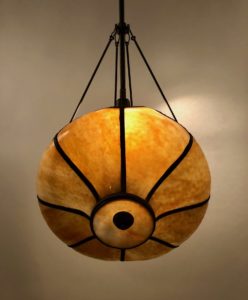
Amber Slag Glass Inverted Dome, Circa 1915
‘
https://www.genuineantiquelighting.net/pc/ID1/3297d/Airy%C2%A0Bulbous_Leaded_Glass_Inverted_Dome_Light.html
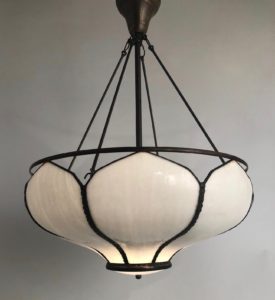
Airy Bulbous Leaded Glass Inverted Dome Light, Circa 1910
I am recommending between 20 and 24 inch Inverted Domes. The Amber works very well with natural woodwork.
Tom
